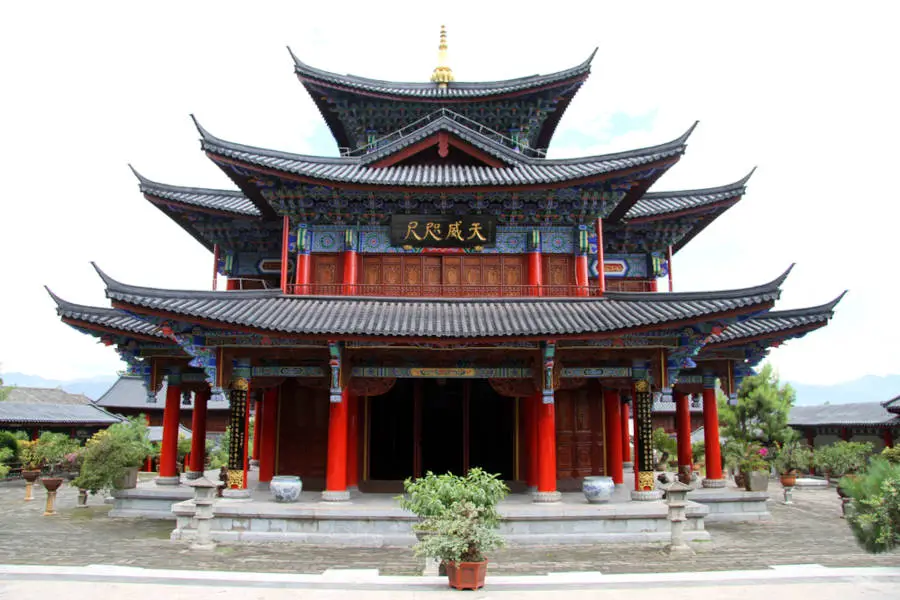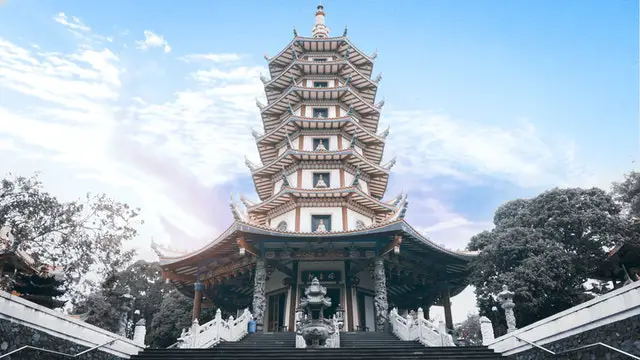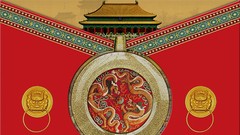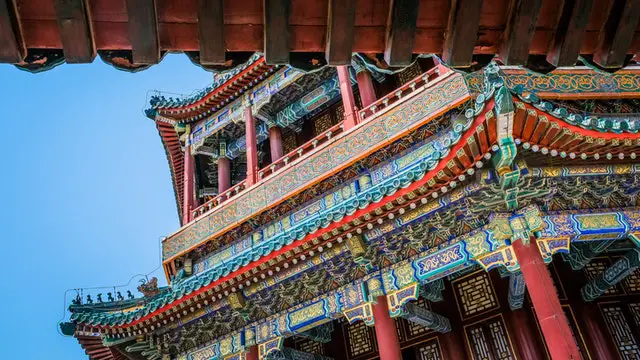
The Chinese Pagoda is considered one of the most unique and important buildings in ancient Chinese architecture with its distinct style of construction. Pagoda structures can be made from various different materials: stone, brick, and wood, among others.
Although pagodas are really famous all over the world and are widely regarded as the signature of Chinese architecture, they actually originated from India. Pagodas are only adopted to the Chinese culture during the times of the Han Dynasty (206 B.C – 220 A.D.), the period when Buddhism gained a significant following in China.
Thus, the Chinese Pagodas that we see today are actually fused from both Chinese and Indian architectures. This architecture was called a Stupa back in ancient India and was originally used as a tomb. In China, it is adopted as a place of veneration and worship, and with different purposes of the building also came the shifts in architecture.
Chinese Pagodas come in various different shapes and forms. Some are perfectly circular, some are hexagonal, and there are also octagonal pagodas. They can also come in a different number of floors. These variations in shapes were caused by the trends of each era; the earliest Chinese Pagodas were circular and square, but the Pagoda shapes changed during the Tang Dynasty (~500 A.D.) as they became more complex with octagonal shapes. The trend changed again during the Song Dynasty (~1000 A.D) when the pagodas were becoming taller and thinner.
Why Is The Pagoda So Important in Chinese Culture?
Before the modern era, the Chinese Pagoda was tightly related to Buddhism. In China today, you’ll see Pagodas within many monastery complexes of especially the larger Buddhist temples. However, as time goes, the Pagoda is now more widely regarded as a cultural thing rather than religious/spiritual.
In the ancient days, aside from being a part of Buddhism temples, the Pagoda is usually also used to store collections of Sarira (Buddhist relics), important artifacts, Buddhist scripture, important sutras, and so on. The Pagoda was also built as a place for civilians and travelers to pray. It was believed that praying inside the Pagoda will prevent natural disasters from the traveler’s village or country. Praying in the Pagoda regularly was also believed to ward off any bad luck and attract good fortune.
However, with the rise of the secular mindset in modern China, the people’s perception of the Chinese Pagodas has changed. In ancient China Pagodas-as religious buildings-were relatively simple structures without too many ornaments. Modern Pagodas, on the other hand, are far more luxurious. The shift of the Pagoda’s function from a religious building to a secular, cultural building has allowed it to be far more fancy and elegant.
Thus, many visitors now come to the Pagoda only to climb and view the surrounding panorama rather than praying inside it. Many also come to the Pagodas for Feng Shui-related purposes (i.e. improve their good luck), and this is also why many ornaments and pillars inside the pagoda often feature intricate carvings of dragons, phoenixes, and any other mythical beast that is related to Feng Shui.
Nevertheless, Chinese Pagodas are now still regarded as one of the most important landmarks in China and should be a major destination for any tourists who want to learn about Ancient Chinese culture and architecture.

What Does The Pagoda Symbolize?
As discussed, Pagoda used to be a strong symbol for Buddhism in China.
In fact, as history goes, when Buddhism gained popularity across China, people wanted to create a symbol to represent Buddhism. Thus, when Buddhism teachers from India introduced the Stupa and its importance in Buddhism, they modified it and created the Pagoda. The earliest Pagodas in China feature thick Buddhist iconographies such as images of Shakyamuni or Sidharta Gauthama.
Now, however, the Chinese Pagoda has shifted in value from a religious symbol into a cultural symbol. The Chinese Pagoda is no longer a sacred place that nobody can’t enter and is more widely treated as an artistic and architectural wonder.
What Were The Pagodas Used For?
When the first Pagodas were built and introduced into the Chinese culture, they played a significant role and actually had a specific function: a tomb.
Many Buddhist teachers in ancient China believed Pagodas carried the deceased spirits to heaven, and thus the earliest Pagodas were built as a place of veneration. The ancient Chinese put Buddha statues to be worshipped inside the Pagodas.
Now that the Pagodas have shifted in value from religious into secular, now its use also widely varies. There are Pagodas that are used to store important documents and treasures, and many believe that there are Pagodas that were specifically built to balance the Feng Shui energy in China. During wartime, the Pagodas can also be used as a watchtower to see and scout the surroundings.
Nowadays, many ancient Pagodas are considered very valuable landmarks and tourism destinations, and many Chinese considered the Pagoda as one of the greatest pride of Chinese history, especially in architecture.
Online Courses about Chinese Culture from Udemy (Aff.link)

Chinese VS Japanese Pagodas
As we know, Pagodas also exist in Japan. Which one is the original one? The answer is not as easy as black and white.
As we know, Japanese architecture derives from the Chinese culture, mainly from the Tang dynasty era. On the other hand, the main architecture of China was influenced by the Ming dynasty era.
From this perspective, although we can agree that the Japanese derive their concept from the Chinese, there are still two different dynasties that influenced their basic architecture.
However, as time goes, by, the integration between the cultures separates their design concepts separately.
If we judge based on the first Pagoda built, then we know that Chinese Pagodas were older, and based on this we can answer that the Pagoda is Chinese. However, when we look at the bigger picture, the Japanese Pagodas can actually be treated as an entirely different entity altogether.
The main difference between the two is the materials used to build the Pagodas:
In China, the Pagodas are more ‘elegant’ in look. The main materials for building the pagoda are typically a mixture of wood, rock, and porcelain, and typically the exterior of the Chinese Pagodas is decorated with luxury ornaments and carvings from gemstones such as jade, ruby, tourmaline, and so on.
Japanese Pagodas, on the other hand, are more classical’ in design, built mainly out of wood with simpler designs and very little ornamentations. Typically the Japanese Pagodas stick with the exposed wood design while the Chinese Pagodas were painted and decorated with many colors.
Another key difference is structure. As discussed above, the Chinese Pagodas’ structures vary between different timelines (dynasties), but the most common design is octagonal.
The Japanese Pagodas, on the other hand, stick with rectangular (four sides) structures.
Related Reading: Chinese Wood Carving – History, Major Schools and Wood Carving Process – Opens in new tab

How Was The Pagoda Built?
Before we can discuss how the Pagoda was built we should discuss its structure.
The Chinese Pagoda’s structure can be divided into three different areas: the base, the body, and the steeple.
The base, as the name suggests, is the main support of the Pagoda’s structure as a whole. The earlier Chinese Pagodas typically had a low base made from brick and stones, only ten to twenty centimeters in height.
However, as time went by, the Tang dynasty developed a new standard for the Pagoda’s base, making it bigger and larger. This allows them to build a bigger pagoda due to the size of the steady and firm base.
The next part is the body of the Pagoda. As the main part of the Pagoda, the structure must be made firm and able to keep it standing in every condition. The Pagoda’s body can be created solid or hollow, and we can categorize it in several different types based on materials:
- Wood is the most basic type of Pagoda’s body that is also the simplest to construct. It features wooden columns around each level of the pagoda, then to make it sturdier, they put beams and brackets on the capital of each column. Verandas with banisters are also built around each story, and the stairs are built inside so we can have access to each floor.
- Brick exterior, wood interiors. The brick exterior is the main part that forms the body, and this type of structure is often called tube-style’ structure since it creates the impression of a hollow tube. On certain conditions, these Pagodas need pillars to be erected at the corners to affirm the support for the floor above. This design typically features spiral staircases.
- Brick pillar. Mainly constructed out of brick and stone. The main body is entirely brick, including the stairs and other components of the complex that are also built out of brick or stone. The floors are linked to the walls and the central pillars. They can be built using arch bonds and stacked bricks around the central pillar. In the former’s case, the landing area is on every level. For the latter, the structure features a central area and a small recess.
The third part to discuss is the steeple, the component that’s located on the roof’s tip, which is typically the signature piece of a Pagoda’s design. The steeple is often ball-shaped or pointed, and the materials used for its construction can vary widely.
The steeple is not only a decoration but has an important function to keep the rainwater away from the building.
As time goes, the roof beams were made simpler to make the structure lighter, allowing the roofs to become more curved at the corners. Also, better designs in roof brackets were implemented, which eventually allow the addition of heavier decorative tiles and statues to the ridges and ends of the roofs.
Can You Live In a Pagoda?
Not all Pagodas are available for guests to stay in, and typically those that permit guests will limit the time these guests are allowed to stay. You can stay for a set amount of time for meditation and praying purposes in certain Pagodas, but it is not permissible to stay overnight in most Pagodas.

Wen Chang Pagoda: The Chinese Pagoda in Feng Shui
In Feng Shui, a Pagoda-shaped charm is considered one of the most important cures, known as Wen Chang Pagoda or can be translated as “Education Tower”. Feng Shui practitioners believe that the Wen Chang Pagoda can be used for converting negative Chi that dwells in one place into a positive Chi. Besides that, they also believe that it will increase scholastic luck. This is why many students in China usually put a Wen Chang Pagoda in their study room.
Wen Chang Pagoda with a different number of floors will have a different meaning:
- A 5-tiered pagoda represents the five elements (Water, Wood, Fire, Earth, Metal), believed to repel all the incoming bad luck that gather from 5 directions.
- The 7-tiered pagoda represents the 7 treasures of Buddhism. It is also related to the 7 northern stars that bring good luck in career and fortune, that’s why this is also usually used as a good luck charm.
- The last one is the 9-tiered pagoda, which represents the completeness in a cycle. It was also believed that this pagoda can reduce instability in life and ward off bad luck.
There are many different possible places to put the Wen Chang pagoda on your property, different placements will produce different effects.
Placing the Wen Chang Pagoda near the entrance will protect and ward your house from any bad omen. For luck in academic study, it’s best to place the Pagoda in the study area. For career advancement, placing the Wen Chang Pagoda charm in the northwest area of the property is recommended.
You can also place the Wen Chang Pagoda in your workplace or business. Placing the Pagoda inside a shop or store is believed to guard the business against loss, and provide protection for your business in general. At your workplace, you can put it behind the place you sit, which is believed to protect you from bad influence and backstabbing co-workers.
Related reading: “Chinese Good Luck Charms To Bring Good Fortune” –Opens in new tab
Stay in Touch
 Join our newsletter by using the forms on this website or click here!
Join our newsletter by using the forms on this website or click here! Follow us on Google News
Follow us on Google News Follow us on Facebook
Follow us on Facebook
Feature Image from Depositphotos





